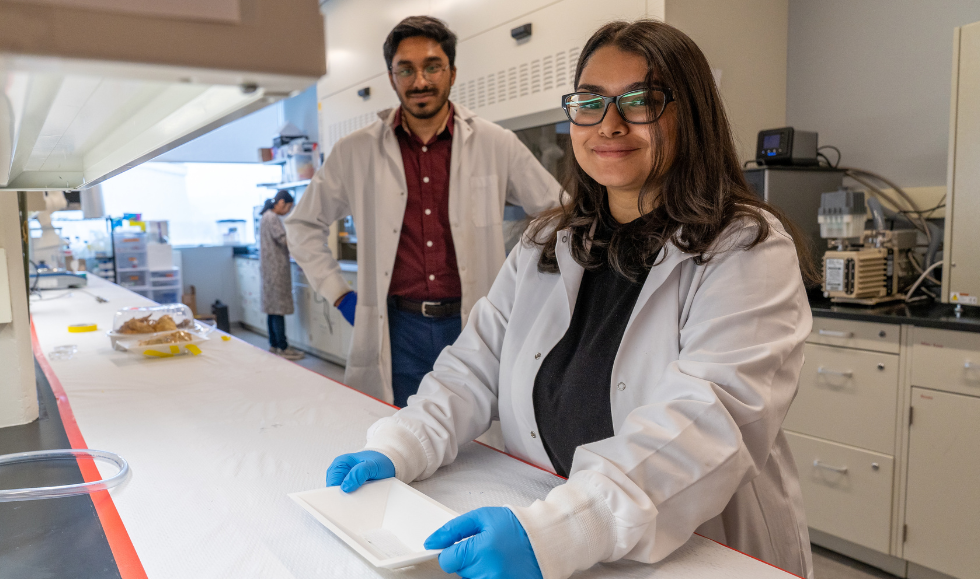McMaster scientists have developed a new packaging tray that has the potential to signal when salmonella or other pathogens are present in packages of raw or cooked food, like chicken.
 Graduate students Shadman Khan, left, and Akansha Prasad are co-lead authors on a paper about a packaging tray that can signal when food is contaminate with salmonella or other dangerous pathogens. Image Credit: Matt Clarke, McMaster University
Graduate students Shadman Khan, left, and Akansha Prasad are co-lead authors on a paper about a packaging tray that can signal when food is contaminate with salmonella or other dangerous pathogens. Image Credit: Matt Clarke, McMaster University
The new technology will allow retailers, producers, and consumers to tell in real-time if the sealed food package’s contents are contaminated without opening it, avoiding exposure to contamination while streamlining clumsy and costly laboratory-based detection processes.
The prototype tray is shaped like a shallow boat and is lined with a food-safe reagent that enables a built-in sensor to sense and signals the existence of salmonella. To assess for other common food-borne contaminants, like listeria and E. coli, the technology could be readily implemented.
This is something that can benefit everyone. We’re hoping this technology will save lives, money, and food waste.
Akansha Prasad, Study Co-Lead Author and Researchers, McMaster University
The study is published in the journal Advanced Materials.
With food safety, there is a lot at stake, according to researcher Shadman Khan, who is also a co-lead author of the paper. Khan adds, “We wanted to develop a system that was reliable, quick, affordable, and easy to use.”
The tray’s sloped sides point juices to a sensor fixed in a window at the bottom. Users can scan the underneath of sealed packages using a cell phone and find instantly if the food is contaminated with no extra laboratory work required.
Having simple, immediate access to this kind of data would facilitate public health authorities, retailers, and producers to isolate and track contamination rapidly, minimizing possibly severe infections and considerably on food waste by recognizing accurately which lots of food required recalling and destroying, in comparison to wide recalls that result in wasting uncontaminated foods.
Across the world, there are around 600 million cases of food-borne sicknesses annually, majorly contributing to the consumption of toxic-contaminated food products.
The McMaster scientists and their co-workers have been studying for many years on associated technologies, focused on producing simple, cheap tools to avoid and detect food contamination.
Their study is part of McMaster’s Global Nexus School for Pandemic Prevention & Response.
Package-based sensors that quantify other settings, such as humidity, are already getting common in Japan and many other places, adds co-author Tohid Didar, an Associate Professor of mechanical and biomedical engineering who holds the Canada Research Chair in Nano-biomaterials.
The McMaster study group on the Lab-in-a-Package project—which features 11 colleagues from the industries of mechanical, biomedical, chemical engineering, medicine and biochemistry—has studied to create a new contamination sensor as flexible and cheap as possible, recognizing food producers are in pressure to keep costs cheap, he adds.
“It’s really just a matter of time before technology like this becomes common all over the world,” Didar states.
“Now that we’ve shown that one kind of food package can reveal contamination without even being opened, we can adapt it to other forms of packaging for other types of foods.”
Didar and his co-worker Yingfu Li, a professor of biochemistry and biomedical sciences, and Carlos Filipe, McMaster’s Chair of Chemical Engineering, have overseen the research.
“Being able to combine packaging and salmonella detection in one system is already very promising,” states Li.
“It also shows that we can add sensing probes for other food-borne pathogens to the same system so the package will check for all of them at once. That’s the next step for us, and we’re already working on it.”
The study has been financially aided by Toyota Tsusho Canada Inc., an indirect subsidiary of Toyota Tsusho Corporation in Japan.
Journal Reference:
Prasad, A., et al. (2023). Advancing in Situ Food Monitoring Through A Smart Lab-in-a-Package System Demonstrated by The Detection of Salmonella in Whole Chicken. Advanced Materials. https://doi.org/10.1002/adma.202302641.